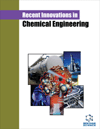
Full text loading...
We use cookies to track usage and preferences.I Understand

The use of bioreactors at sewage treatment plants solves an environmental problem at water utilities in the Udmurt Republic, as sludge beds are overflowing due to the fact that tens of tons of sewage sludge have been stored on sludge beds every day since the 1980s and amount to hectares of land.
The results of experimental studies on the processing of wastewater sludge in the Biotechnology laboratory were analyzed to improve the efficiency of the technological process for the disposal of organic waste using a biogas plant and a process activator.
The methodology for preparing a biogas plant for entering the operating mode and further operation is presented. An algorithm for experimental studies using a biogas plant and obtaining biogas from organic waste is presented.
The article presents an analysis of the results of experimental studies of sewage sludge treatment under periodic psychrophilic and, subsequently mesophilic operating conditions of the bioreactor in relation to the climatic conditions of the Udmurt Republic. The results of experimental studies in the article are presented in the form of graphical dependencies of the volume of produced biogas on the temperature and duration of the process.
The article presents the dynamics of changes in the volume of produced biogas depending on the increase in temperature and duration of the process under the mesophilic operating mode of the bioreactor. On the first day of the experiment under the mesophilic mode in the bioreactor, the volume of produced biogas was 2.15% (7.41 g) at a temperature of 32°C; with increasing temperature, the volume of produced biogas increased. The maximum biogas production was observed on the fifth day of the experiment under the mesophilic mode and amounted to 7.66%, which corresponds to 26.41 g.
The recommended loading volume of biomass into the bioreactor is 80 liters. In accordance with the actual conditions of the sewage treatment facilities, the volume of biogas produced will be 26.000 m3 of methane daily during the period of anaerobic fermentation in the bioreactor. To solve the environmental problem, it is necessary to install a complex of bioreactors at the water utilities of the Udmurt Republic.

Article metrics loading...

Full text loading...
References


Data & Media loading...